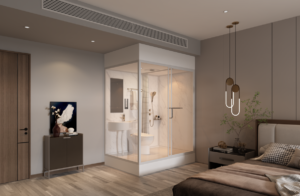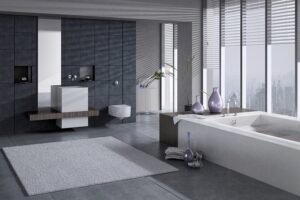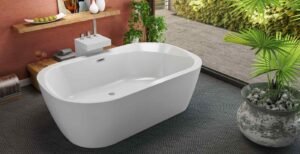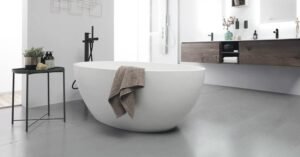Most comfortable bathtub shapes and their pros and cons.
Bathtubs are often regarded as the pinnacle of bathroom luxury and provide a sensual experience. Bathtubs are often the centerpiece of many bathrooms, so choosing the right shape for your focus is essential. In many cases, the space you can choose depends on heat retention, comfort, and available space.
Some bathtub shapes are more comfortable than others. Each shape and style has its strengths and weaknesses. Overall, the classic oval bathtub offers great fun to the user while remaining visually appealing with cleanliness. In addition, the oval bathtub can be used as a freestanding bathtub or placed in a built-in rectangular bathtub.
So, let’s get started!
Oval bathtubs
Different bathtub shapes have different qualities. Unlike straight and corner tubs, Oval tubs have a unique waist angle that allows the body to rest completely while bathing. It provides the support and comfort your back needs without getting in the way of the bathtub faucet. Oval bathtubs are very common. In short, it’s much easier to achieve perfect length and depth than in other shapes and styles.
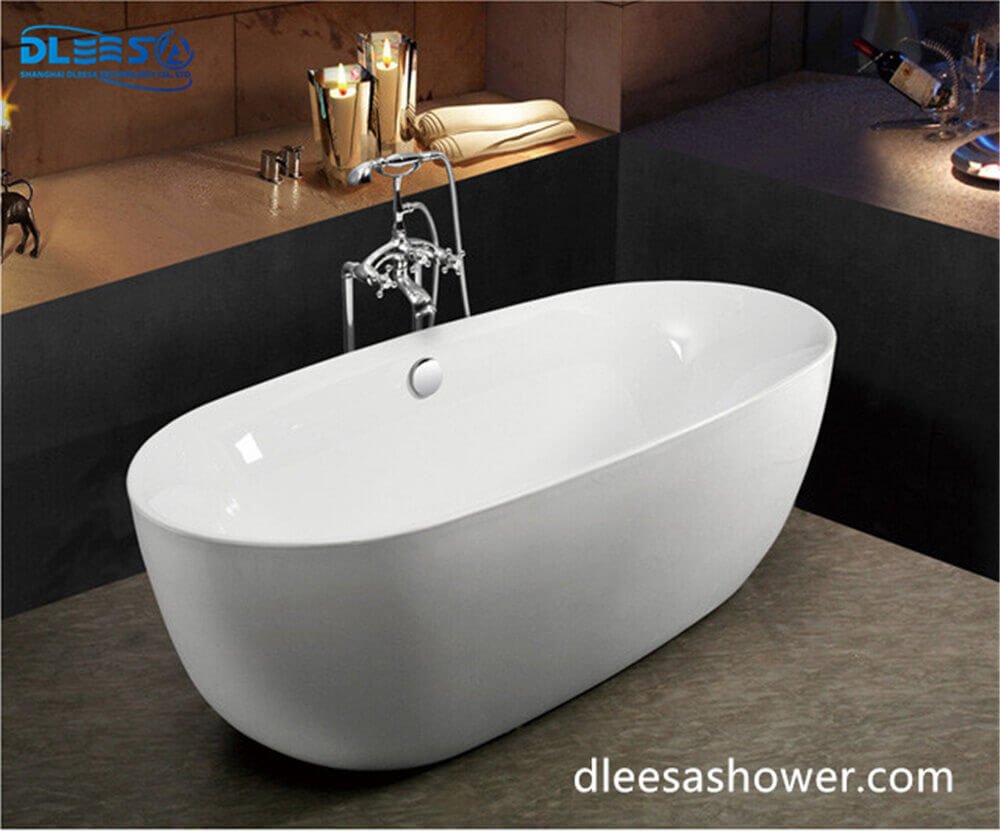
The oval is very easy to clean compared to other bathtubs. This shape is suitable for a continuous surface next to a round tub so that dirt can be easily removed. There are no hard corners or sharp lines where dirt can easily collect. It can be challenging to remove with a simple cleaning tool.
Oval bathtubs, especially those with self-supporting bathtubs, are made of dense materials and are often heavy bathtubs. Cast iron and stone resin is a very durable and weighty material that retains heat. Depending on the space available, it may be necessary to reinforce the bathroom floor to install such a bathtub. If reinforcement is not an option, lighter materials such as acrylic can be used to build an oval tub. This is often suitable for modern freestanding and double-sided tubs. You can also make corner tubs or built-in tubs with a lighter.
Pros:
The benefits of oval tubs are:
● One of the most comfortable tub shapes.
● Available in different configurations to suit different bathrooms.
● Easy to clean as it reaches every corner.
● Beautiful shape and design.
Cons:
The disadvantages of the oval bathtubs are:
● Very heavy and needs to be reinforced on the floor.
● Deck space is limited.
● Limited space for storing items with a freestanding bathtub.
The oval bath has many options and benefits, one of which is a high level of comfort. However, because it is mainly contained in heavier materials such as cast iron, the floor needs to be reinforced to support the weight. Still, the oval tub is among the most highly rated tubs you can find. Lightweight bathtub materials such as acrylic can be used to avoid reinforcing the floor.
Corner bathtubs
Corner tubs have three or five sides designed to fit in a corner. It can come in various shapes and sizes as long as it fits in the corner. These tubs can be taller and more profound than other tubs without taking up too much space in the rest of the bathroom. They also allow you to have a tub where other shapes are impractical. The corner bathtub is one of the most comfortable bathtubs.

Pros:
The benefits of the Corner tab are:
● Can take advantage of corners and other dead spaces that other types of tabs would not usually fit.
● The corner bath has a unique shape and adds beauty to the bathroom.
● Due to its good shape, it has more bathing space than other bathtubs.
● Provides ample deck space.
● Can be easily combined with a shower.
● You can choose from a variety of shapes and sizes.
Cons:
The disadvantages of the Corner Tub are:
● Can be very bulky physically and visually.
● Some corners of the tub are hard to reach and can be challenging to clean.
● Some shapes are difficult to get in and out of.
The comfort of a corner bath depends on many aspects, including shape and size. Corner tubs make it easier to get a deep tub with a shower than most other tubs. However, all corner tubs are said to be some of the most comfortable, regardless of whether you choose an acrylic or cast iron (or other material) tub.
Round bathtubs
The next popular bathtub shape is the round bathtub, one of the most comfortable freestanding bathtubs. All-round bathtubs can be placed almost anywhere in the bathroom.
The round bathtub is a Japanese bathtub because it needs to stand upright rather than recline. This is advantageous if you prefer this sitting position in the bath. However, it can be a limitation, especially for those with mobility issues and tall users.

Pros:
The round bathtub has the following benefits:
● Economical in space.
● A deep bathtub provides comfortable upright bathing.
● Brings beauty to the bathroom.
● Can be lowered to save space.
● Large enough to accommodate multiple people.
Cons:
● The disadvantages of the round bathtub are:
● Upright posture is not comfortable for everyone.
● The round shape creates a dead space in the bathroom.
● Due to the small space inside, it cannot be easily stretched.
● Difficult to get in and out.
The ideal bathtub back angle is 115 ° on the inside and 65 ° on the outside. This allows you to lean back a little when using the tub. However, the waist angle of the round bathtub is 90 °. Therefore, a round bathtub is not the most comfortable. Even then, the round tub was a two-person tub with many great features.
Hourglass bathtub
The hourglass tub is shaped like an hourglass or figure eight, with an oval top but a curved center when viewed from above. The result is a beautiful and very comfortable bath with armrests.
The Hourglass Bathtub is a modified version of a rectangular bathtub with an hourglass shape molded inside the bathtub. This design provides great armrests and is often curved to provide proper back support. Many hourglass tubs are beautifully designed with ample deck space for soap and shampoo.

The molding shape reduces the space inside the bathtub. The hourglass design is space inefficient, especially in a standing bathtub, and is generally considered for single use. Due to its size and weight, it can be challenging to integrate this shape, even in the bathroom. Reinforced flooring is often required. In addition, the unique shape also means that it is hard to get out. Large deck space means it’s not easy to climb.
Pros:
The benefits of the hourglass tab are:
● Very comfortable due to curves and contours.
● Provides ample deck space for most users.
● Beautiful.
● Available in many shapes and designs.
Cons:
The disadvantages of the hourglass tub are:
● The shape of the hourglass wastes some bathtub space.
● More challenging to install than traditional molded pans.
● It can be not easy getting in and out of the bathtub.
The hourglass bathtub is one of the best ergonomic bathtubs due to its comfortable contours and curves. The backrest is tilted correctly and can be used for a long time without getting tired.
Slipper bathtubs
The slipper tub has one or two sides and is raised and sloping. Raise one side for a single slipper pan, and raise both sides for a double slipper pan. These ergonomic bathtubs are extremely easy to use and are most often used as deep bathtubs for two people.
The slipper tub has a luxurious form. The shape of this tub, also known as a sloping tub, has a slop on one or both sides. This provides neck support and enhances user comfort-not available with corner tubs. Slipper baths are generally designed for two people, with both sides of the bath sloping. The center of the bathtub is also a little low, and there is a notch for the arm to rest on.

This form of freestanding bath is ideal for large master bathrooms. The ergonomic bathtub shape, like the slippers, not only has an attractive appearance but is also an amazing place for couples to relax. This style is the perfect option for two people or if you’re looking for maximum comfort at no cost.
According to some users, there isn’t too much space. Due to the extended slope, slipper tubs take up much more space and floor than traditional tubs. Slippers are often heavy due to the extra material and can be more challenging to install than lightweight baths. If you like this shape, you may need to consider more space, reinforced floors, and additional costs.
Pros:
The benefits of the slipper tab are:
● Very comfortable with its ergonomic shape.
● One of the best baths for two people.
● Beautiful design.
Cons:
The disadvantages of the slipper tab are:
● Due to its large size, there can be dead space around it.
● Due to its heavy weight, additional floor support may be required.
● More expensive than other bathtub shapes.
The Slipper Bathtub is a great luxury tub because of its classic shape and superb comfort. However, bringing this tub home is not cheap and can be pretty expensive.
Square bathtubs
In a square tub, all four sides are the same length. They are usually large tubs to provide ample space for bathing. You can get an oversized square bathtub large enough to accommodate multiple users. Square tubs can be made to have a round bathing fountain to provide deeper depth and deck space.
The square tub shares many of the advantages of a rectangular tub. Features include installing the design in a corner as a corner tub or a niche with few issues. There are also several options for non-porous materials to retain heat, such as acrylic, natural stone, and cast iron. The square tub shape can also provide a round tub for added comfort to better align and support your body.

The design includes double-sided and self-supporting options. Due to the square shape, a larger tub (and therefore more floor space) is usually required to provide adequate immersion space. Getting in and out of the tub can be a bit difficult due to the distance on the tub’s sides. If space matters, a shower is an alternative.
Pros:
The benefits of a square bathtub are:
● Provides a fountain for deep bathing.
● Can be dropped into the bathroom to save space.
● Can be installed in the corner of the bathroom to save space.
● Provides ample deck space.
● Smaller footprint than other bathtubs.
● It can be equipped with a round fountain to make it more comfortable.
Cons:
The disadvantages of the Square Tub are:
● It may be challenging to get in and out.
● It can be challenging to keep clean because the corners are hard to reach.
● Must be large to provide ample space for bathing.
The square tubs come in various sizes, and you can use shorter tubs that focus more on depth than horizontal size. Still, it offers some of the best features when it comes to comfort and deck space.
Rectangular bathtubs
The rectangular bathtub has two long sides and two short sides, making it the most popular type of bathtub. They are also available in many configurations, with 60-inch soak tubs (lengths) being the most common length. Deep alcove-style bathtubs are also common. The rectangular bathtub can also stand on its own. Depending on the material used, there is also a rectangular light tub.
The rectangular bathtub is often the most common type of bathing space at home. This style can be placed in a more familiar place where people want a bathtub. This includes features such as alcoves and room corners to maximize bathroom space. Often found on walls, the rectangular shape is a standing bathtub. A stationary bathtub occupies more floor space but makes more statements.

This design is generally one of the most affordable and cheap options to choose from other materials. The rectangular shape fits almost any tub style, including submerged tubs, corner tubs, built-in tubs, and combo tubs. L-shaped and P-shaped bathtubs are extensions of traditional designs with many similar aspects.
However, the rectangular shape is considered challenging to clean due to the hard-to-reach corners and bulky frame. Installing this type of tub between the floors requires a lot of wall space in bathrooms. Other features need to be considered as different shapes fit different spaces. This is an important consideration.
Pros:
The advantages of the rectangular tank are:
● Cheaper than other shapes.
● It has a more apparent and more linear appearance.
● Space-saving thanks to its convenient shape.
● Most bathrooms can accommodate linear shapes.
● Many installation options (niche, self-contained, embedded, corner, drop-in).
● Provides ample storage and deck space.
Cons:
The disadvantages of the rectangular bathtub are:
● Large and heavy shapes can look clumsy and uninteresting.
● The bathtub between the alcove occupies a lot of wall space.
● It can be challenging to keep clean because the corners are hidden (especially the alcove between the floors).
If you need a bath with a shower, you will need a rectangular tub, depending on the space available and the bath size. You can enjoy bathing and showering in one place with a shower and bathtub combo.
Specialty bathtubs
In addition to the typical bathtub shape, you can choose unique shapes such as octagons, triangles, hearts, etc. These are unique forms that cost more than the conversational version. It also requires a unique installation that requires a specialist.

Final Thoughts
An oval bathtub can do everything well enough, rather than being better in a particular area. The shape is easy to install, looks beautiful, and provides proper back support for comfort.
In addition, the variety of styles, sizes, and colors in stock in many places makes oval bathtubs more affordable. This shape is a practical choice that not only saves your wallet but also saves your time with easy maintenance.



